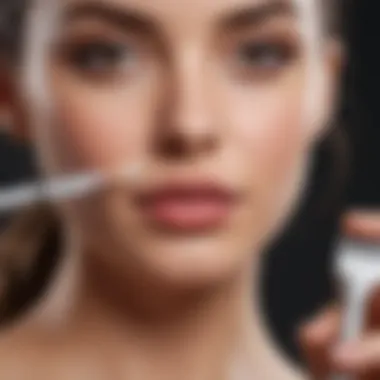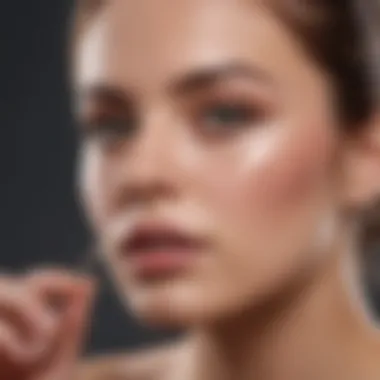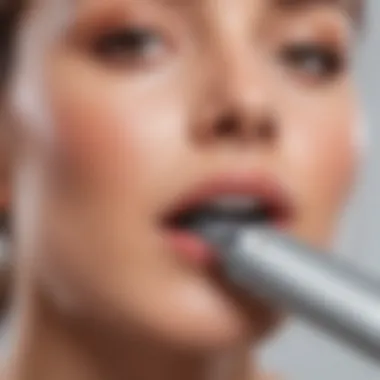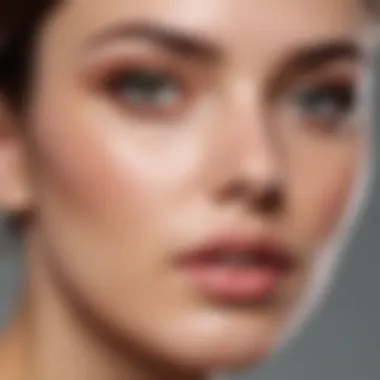Effective Techniques for Upper Lip Hair Removal


Intro
Upper lip hair removal is a significant aspect of personal grooming for many women. As aesthetic standards evolve, the demand for effective solutions increases. This article aims to dissect various methods, from traditional practices to contemporary innovations. By examining their merits and limitations, readers will be better equipped to make informed choices. The discussion will also consider skin care, target demographics, and aftercare, ensuring a holistic approach.
Trending Topics
Current Fashion Trends
In today’s world, beauty standards are constantly shifting. The trend toward smooth, hair-free skin has gained traction. Influential figures in fashion and celebrity culture often promote this ideal through various media. Social platforms like Instagram also reinforce these notions, as images of flawless skin circulate widely. Thus, many women feel pressured to maintain similar standards.
Beauty Innovations
Recent advancements in beauty technology have transformed hair removal methods. Laser hair removal, for instance, has become increasingly accessible. Devices like Philips Lumea and Braun Silk-expert utilize light energy to target hair follicles. These techniques are praised for their precision and long-lasting results. Furthermore, at-home options continue to grow in popularity, appealing to those seeking convenience.
Step-by-Step Guides
Hair Removal Techniques
- Waxing
This method involves applying warmed wax to the skin, covering the hair, and then quickly pulling it away. Waxing can deliver smooth results for several weeks. However, skin sensitivity is a common downside. - Threading
An ancient practice that uses a thin thread to remove hair, threading is often favored for its precision. It is especially effective for shaping eyebrows and removing upper lip hair. - Depilatory Creams
These creams dissolve hair at the skin’s surface. While they can be effective, some users experience irritation or allergic reactions. - Laser Hair Removal
As noted earlier, this technique offers long-term solutions. However, it may require multiple sessions and is generally more costly.
Post-Care Tips
- Moisturize: After any hair removal method, applying a soothing cream or aloe vera helps calm skin irritation.
- Avoid sun exposure: Limiting sun exposure post-treatment is essential to prevent hyperpigmentation.
- Stay away from makeup: Allow skin to breathe for a day post-removal.
Product Reviews
In-Depth Analysis of Popular Items
For those considering at-home hair removal products, several have been reviewed positively. The Nair Hair Removal Cream is favored for its ease of use. Similarly, the Sally Hansen Wax Strip Kit enables efficient hair removal with minimal mess.
Comparative Reviews
A comparison of waxing and threading shows that while waxing might cover a larger area, threading is often preferred for accuracy. Many users also report less discomfort with threading than waxing, as it does not involve the use of heat or chemicals.
"Choosing the right hair removal method is crucial for achieving desired results and maintaining skin health." - Beauty Expert
Preface to Upper Lip Hair Removal
Upper lip hair removal is a significant topic that resonates with many individuals, particularly women. The presence of hair on the upper lip can be a source of self-consciousness, impacting one's confidence and social interactions. Understanding the various methods of removal is crucial for making informed choices that align with personal preferences and skin types.
This article aims to provide a comprehensive guide on removing hair from this delicate area. We will explore cultural perspectives, the reasons individuals seek upper lip hair removal, and various methods that can be employed. Each approach has its unique benefits and considerations that will be discussed in detail, providing readers with ample details to make educated decisions.
Cultural Perspectives on Facial Hair
Cultural beliefs play an integral role in shaping attitudes towards facial hair. Different cultures view female facial hair in various lights; in some societies, it is considered normal, while in others, it is often discouraged.
For instance, in many Western cultures, the removal of visible hair on the face is sometimes viewed as a beauty standard. This leads many women to seek hair removal methods to conform to societal expectations. On the contrary, in certain cultures, having facial hair may not hold negative stigma and may even be accepted or embraced.
Understanding these cultural differences can help women navigate their feelings about upper lip hair. Acknowledging that hair removal is influenced by cultural beliefs allows for greater reflection on personal choices, reducing feelings of shame or insecurity.
Reasons for Upper Lip Hair Removal
People choose to remove hair from their upper lip for diverse reasons. One of the most prominent reasons is aesthetic preference. Many women desire a smooth and hair-free upper lip to enhance their overall appearance. This desire is influenced by fashion trends and media representations of beauty.


Additionally, keeping the upper lip hair-free can be associated with hygiene. Some individuals feel cleaner and fresher without facial hair. Moreover, the perception of professionalism in certain fields may compel individuals to remove unwanted hair.
There are also psychological aspects. For many, removing hair may lead to increased self-esteem and confidence, allowing for more expressive social interactions. The perception of facial hair can vary greatly amongst individuals, and the decision to remove it is often deeply personal.
In summary, upper lip hair removal is not merely a cosmetic choice; it embodies cultural, aesthetic, and personal factors. This necessitates a thoughtful approach to the various methods available for achieving hair removal.
Understanding Different Hair Types
Understanding the different hair types is crucial when discussing upper lip hair removal. Each individual has unique hair characteristics that can influence removal methods. This section will elaborate on the important elements of facial hair, including specific features such as thickness, color, and growth patterns. Knowing these traits can aid in pinpointing the best methods for effective removal, ultimately leading to better skin health and improved results.
Characteristics of Facial Hair
Facial hair is distinct from body hair in several ways. It generally grows in different textures and densities. Some women may experience fine and soft hair, while others may have thick and coarse strands. The color of the hair can also varies from light blonde to dark brown or black. Each of these characteristics plays a significant role in how effective certain removal methods can be.
- Thickness: Thicker hair may require more robust removal techniques, while thinner hair could be managed with gentler methods.
- Color: Dark hair can be more noticeable against lighter skin, prompting a stronger need for removal. Conversely, light hair on fair skin may not stand out as much.
- Growth Patterns: This includes how fast the hair grows back and the direction in which it grows. Understanding these patterns can help choose the right timing for removal and predict how often maintenance will be required.
These factors make it essential for women to assess their own hair types before deciding on a removal method.
Impact of Hormones on Hair Growth
Hormones play a significant role in hair growth patterns, including those on the upper lip. Fluctuations in hormone levels can cause changes in hair growth, affecting both density and speed of regrowth. Key hormones that impact hair include estrogen, testosterone, and others.
For instance, conditions like polycystic ovary syndrome (PCOS) can lead to elevated testosterone levels, resulting in increased facial hair growth in some women. Understanding how one's hormone levels can influence hair growth is essential. Here are some key considerations:
- Hormonal Fluctuations: These can be particularly noticeable during menstrual cycles, pregnancy, or menopause, leading to changes in hair characteristics.
- Medical Implications: If hair growth is sudden or excessive, it may indicate an underlying health condition. Consulting a healthcare provider can offer insights.
- Management Options: Be aware that some methods may be more effective depending on hormonal levels. For instance, laser hair removal often works better on darker hair.
Common Methods for Upper Lip Hair Removal
The removal of upper lip hair is a significant topic for many individuals. With various methods available, understanding the options is essential for making informed choices. This section will detail common techniques ranging from traditional methods to modern solutions. Each method has unique benefits and considerations that can help individuals select what fits best for their skin type, hair type, and personal preferences.
Shaving
Benefits of Shaving
Shaving is one of the most accessible methods for removing upper lip hair. It is fast, affordable, and can be done at home without the need for professional assistance. A key characteristic of shaving is its immediate results; individuals can achieve a smooth upper lip in a matter of minutes. Additionally, shaving does not require waiting for hair to grow to a certain length, making it convenient for those who prefer quick touch-ups.
Drawbacks of Shaving
Despite its benefits, shaving has some drawbacks. A common concern is the potential for skin irritation, especially for sensitive skin types. These irritations may manifest as redness or bumps, which can be uncomfortable. Moreover, the regrowth of hair can be noticeable very quickly, often within a day or two, which can lead to frequent shaving sessions. Some may also experience a coarser texture upon regrowth.
Best Practices for Shaving
To ensure positive outcomes while shaving, following best practices is paramount. First, using a clean, sharp razor is crucial to prevent cuts and irritation. It is also advisable to hydrate the skin with a shaving cream or gel designed for women. Shaving in the direction of hair growth can reduce the likelihood of ingrown hairs. Above all, moisturizing the skin after shaving is essential to soothe and protect the delicate area.
Waxing
Types of Waxing
Waxing remains a popular method for upper lip hair removal due to its longer-lasting results. There are different types of waxing, including soft wax, hard wax, and strip waxing. Soft wax is generally applied in a thin layer and removed with cloth strips, while hard wax is more suitable for sensitive areas as it hardens on the skin and can be pulled off without strips. This variety allows individuals to choose a waxing method that aligns with their comfort and hair type.
Pros and Cons of Waxing
The primary advantage of waxing is the extended time between hair removal sessions, often ranging from three to six weeks. This means less frequent maintenance compared to shaving. However, waxing can be painful, particularly for those who have never tried it before. Skin reactions, such as redness or bumps, are also common, and maintaining hygiene during the process is critical to avoid infections.
Waxing Techniques


Proper waxing techniques enhance the removal process and reduce discomfort. Before waxing, it is beneficial to exfoliate the skin lightly to prevent ingrown hairs. Applying a thin layer of wax, following the direction of hair growth, ensures more effective hair removal. After waxing, applying a soothing lotion can calm the skin and reduce irritation.
Threading
Advantages of Threading
Threading is a traditional method for hair removal that utilizes a thin thread to pull hairs from the follicle. It offers precise control, which is particularly advantageous for shaping areas like the upper lip. This method is chemical-free and can be suitable for individuals with sensitive skin as it typically causes less irritation than other methods.
Disadvantages of Threading
While threading has its advantages, it comes with some drawbacks. The main issue is that threading can be painful, especially for those who are not accustomed to it. Additionally, finding a skilled practitioner can be challenging; poor technique can lead to uneven results or skin irritation.
Threading Techniques
To maximize the benefits of threading, it is best to choose a skilled professional. Before your appointment, it helps to cleanse the area to remove oils. It may also be useful to apply a soothing lotion afterward to reduce potential irritation.
Depilatory Creams
How Depilatory Creams Work
Depilatory creams are chemical formulations that dissolve hair at the skin's surface. Their effectiveness lies in special ingredients that break down protein structures in hair, making it easy to wipe away. This method is painless and can result in a smooth finish similar to waxing or shaving.
Safety Considerations
Safety is a primary concern when using depilatory creams. Always perform a patch test to check for allergic reactions. Moreover, follow the instructions carefully to avoid skin burns. Those with sensitive skin should approach this method with caution, as the chemicals can sometimes cause irritation.
Application Tips
For optimal results when using depilatory creams, apply a thin, even layer over the upper lip area. Timing is essential; leaving the cream on for too long can lead to discomfort. Rinse thoroughly with cool water afterward, and apply a soothing moisturizer to combat dryness.
Laser Hair Removal
Effectiveness of Laser Treatment
Laser hair removal is a modern option that offers long-term solutions to excessive upper lip hair. This method utilizes concentrated light to target hair follicles, weakening them over time. Many individuals find success with laser treatment, as the results can lead to reduced hair growth significantly.
Long-term Benefits
One of the most significant long-term benefits of laser treatment is the potential for hair permanently removing over multiple sessions. This reduced regrowth not only eases maintenance but also saves time and money in the long run. Individuals often report smoother skin with fewer issues like irritation or ingrown hairs, which can commonly occur with other methods.
Costs and Accessibility
While laser hair removal is effective, it can be costly compared to other methods. Pricing often depends on the practitioner's expertise and geographical location. Accessibility may also be limited to certain clinics specializing in this treatment. It's essential to research and find reputable providers before proceeding.
Choosing the Right Method for You
Selecting the most suitable approach for upper lip hair removal is crucial for both aesthetic and skin health reasons. Women of all ages and backgrounds may face different challenges related to hair removal. Personal preferences, skin type, hair characteristics, and lifestyle choices all play key roles in determining which method will be both effective and comfortable. In a market flooded with products and techniques, understanding individual needs leads to better decisions and more satisfying results.
Skin Sensitivity Considerations
The skin on the upper lip is often delicate and may react differently to various hair removal methods. Some individuals may have sensitive skin that is prone to irritation, redness, or allergic reactions. Taking this into account is vital when choosing a method.
- Shaving may be suitable for those with normal skin, but if a person has very sensitive skin or conditions like rosacea or eczema, they should avoid it.
- Waxing can lead to adverse reactions as well, particularly if the skin is easily irritated. Testing a small patch of skin before proceeding with full treatment is advisable.
- Threading is generally a safer option for sensitive skin. It avoids the use of chemicals and has fewer irritants compared to wax.
Overall, it’s important to identify your own skin type and any specific sensitivities before making a decision about hair removal methods. Consulting a dermatologist can also provide personalized insight and advice.


Hair Density and Texture
Hair density and texture significantly influence the effectiveness of different hair removal methods. Hair that is coarse and thick may require a more aggressive removal technique than fine hair, which can be easily managed. Understanding these characteristics can help in achieving desired outcomes.
- Thick hair may respond better to laser hair removal or waxing, as these methods effectively target strong hair roots.
- On the other hand, fine hair might be efficiently handled with techniques like shaving or depilatory creams.
Identifying these traits before selecting a method not only promises better results but also minimizes the chances of irritation or unintended consequences.
Lifestyle Factors
Lifestyle choices play a pivotal role when it comes to selecting a hair removal strategy. One should consider how often they can commit to hair removal routines and what fits well into their daily schedule.
- If a person leads a busy life, methods like laser treatment may be ideal since they offer long-lasting results needing fewer sessions.
- For individuals who prefer quick solutions, shaving can be a fast and effective approach, though it may need to be done frequently.
- Waxing can be suitable for those who can allocate a specific time every few weeks for their grooming.
Moreover, social activities or professional environments may require certain grooming standards. Understanding these practical aspects helps individuals choose a method that aligns with their lifestyle and personal commitments.
Post-Removal Care
Post-removal care is an essential aspect of facial grooming that often does not receive adequate attention. After hair removal from the upper lip, the skin can be sensitive and prone to irritation. Therefore, understanding how to care for the skin post-treatment can make a significant difference in both comfort and the overall appearance of the skin.
Soothing the Skin
One of the primary concerns after hair removal is skin sensitivity. It is common to experience redness or a burning sensation. To soothe the skin effectively, consider using gentle, hydrating products. Aloe vera gel is ideal due to its natural soothing properties. It can alleviate discomfort and promote healing.
Additionally, using cold compresses or ice packs wrapped in a cloth can help reduce swelling and calm irritation. Make sure to apply these remedies gently and avoid excessive pressure on the skin.
Preventing Irritation
Preventing irritation is crucial for maintaining healthy skin after hair removal. There are few important practices to consider. First, avoid touching the treated area with unclean hands. This can introduce bacteria and lead to potential infections.
Using non-comedogenic and fragrance-free products is also advisable to prevent breakouts. Avoid heavy makeup, especially products containing harsh chemicals, in the days following hair removal. Instead, try light mineral powders if needed.
It’s best to give your skin time to breathe after treatment, allowing it to recover fully.
Moreover, limiting sun exposure is vital. UV rays can exacerbate irritation. Therefore, use sunscreen on exposed areas and consider wearing a wide-brimmed hat if sun exposure is unavoidable.
Long-term Skin Care Recommendations
Long-term skin care for the upper lip is a commitment that pays off. Regular exfoliation, but not immediately after hair removal, can prevent the buildup of dead skin that might clog pores. Once your skin has fully healed, consider gentle exfoliant products to maintain smooth skin.
Hydration is another key factor. Use a quality moisturizer daily. Look for ingredients like hyaluronic acid or glycerin that lock moisture in the skin.
Lastly, consider consulting a skin care professional or dermatologist for personalized advice based on your skin type. They can recommend specific treatments or products that will best preserve the health of your skin and enhance its appearance over time.
Epilogue
In this article, we have explored the various methods for removing hair from the upper lip, recognizing their unique benefits and limitations. Understanding these options is vital for anyone looking to refine their grooming routine. Each technique provides distinct advantages, such as immediate results from shaving or long-lasting effects from laser treatments.
Choosing the right method is influenced by individual skin sensitivity, hair characteristics, and lifestyle factors. It is essential to prioritize skin health and comfort when selecting a removal technique, as improper methods can lead to irritation or adverse reactions. An informed choice in this domain can substantially enhance both aesthetic outcomes and personal confidence.
Summary of Best Practices
- Assess Your Skin Type: Recognizing if you have sensitive skin will guide you towards gentler methods like threading or depilatory creams.
- Evaluate Hair Density and Texture: Thicker hair may respond better to stronger methods like waxing or laser treatments.
- Follow Aftercare Instructions: Post-removal care is crucial. Applying soothing lotions or avoiding sun exposure can mitigate irritation.
- Stay Informed on Technique Updates: Innovations in hair removal techniques can provide more effective and safer options. Keeping up with the latest research is beneficial.
Encouraging Informed Choices
Making informed choices about upper lip hair removal is essential. It is advisable to:
- Research the Options: Know the pros and cons of each method. Reliable online resources can provide current information.
- Consult Professionals if Needed: For those uncertain about procedures or skin reactions, seeking advice from licensed estheticians can be helpful.
- Consider Long-term Effects: Each treatment varies in durability and skin impact. Weighing these factors can guide towards the most suitable method.
Ultimately, the aim is not just to remove hair, but to maintain healthy skin throughout the process. The choices we make in grooming routines should reflect our individual needs and preferences.



